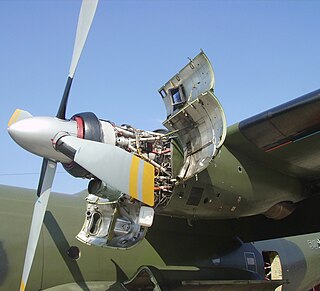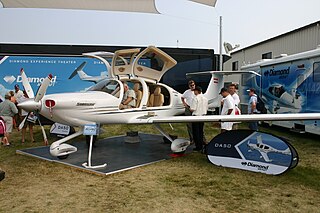
The Antonov An-24 is a 44-seat twin turboprop transport/passenger aircraft designed in 1957 in the Soviet Union by the Antonov Design Bureau and manufactured by Kyiv, Irkutsk and Ulan-Ude Aviation Factories.

The Antonov An-10 Ukraina is a four-engined turboprop passenger transport aircraft designed in the Soviet Union.

The Pratt & Whitney Canada PW100 aircraft engine family is a series of 1,800 to 5,000 shaft horsepower turboprops manufactured by Pratt & Whitney Canada. Pratt & Whitney Canada dominates the turboprops market with 89% of the turboprop regional airliner installed base in 2016, leading GE Aviation and Allison Engine Company.

The Antonov An-14 Pchelka or Pchyolka, Bdzhilka is a Soviet utility aircraft which was first flown on 15 March 1958. It was a twin-engined light STOL utility transport, with two 300 hp Ivchenko AI-14RF radial piston engines. Serial production started in 1966, and about 300 examples were built by the time production ended in 1972. The An-14 failed to replace the more successful An-2 biplane, which was manufactured until 1990,. The An-14's successor, the An-28 with turboprop engines, is still manufactured at PZL Mielec factories in Poland, under the names PZL M28 Skytruck and PZL M28B Bryza.

The Kuznetsov NK-12 is a Soviet turboprop engine of the 1950s, designed by the Kuznetsov design bureau. The NK-12 drives two large four-bladed contra-rotating propellers, 5.6 m (18 ft) diameter (NK-12MA), and 6.2 m (20 ft) diameter (NK-12MV). It is the most powerful turboprop engine to enter service.

The Rolls-Royce RB.109 Tyne is a twin-shaft turboprop engine developed in the mid to late 1950s by Rolls-Royce Limited to a requirement for the Vickers Vanguard airliner. It was first test flown during 1956 in the nose of a modified Avro Lincoln. Following company naming convention for gas turbine engines this turboprop design was named after the River Tyne.

The Progress D-27 is a three-shaft propfan engine developed by Ivchenko Progress, and manufactured by Motor Sich in Ukraine. The gas generator was designed using experience from the Lotarev D-36 turbofan. The D-27 engine was designed to power more-efficient passenger aircraft such as the abandoned Yakovlev Yak-46 project, and it was chosen for the Antonov An-70 military transport aircraft. As of 2019, the D-27 is the only contra-rotating propfan engine to enter service.

The Diamond DA50 is a five seat, single-engine, composite aircraft designed and built by Diamond Aircraft Industries. First shown in 2006, it made its maiden flight on 4 April 2007. The project has been proposed to be powered by several different engines, but was certified on 9 September 2020 with the Continental CD-300 diesel.

The Honeywell T55 is a turboshaft engine used on American helicopters and fixed-wing aircraft since the 1950s, and in unlimited hydroplanes since the 1980s. As of 2021, more than 6,000 of these engines have been built. It is produced by Honeywell Aerospace, a division of Honeywell based in Scottsdale, Arizona, and was originally designed by the Turbine Engine Division of Lycoming Engines in Stratford, Connecticut, as a scaled-up version of the smaller Lycoming T53. The T55 serves as the engine on several major applications including the CH-47-Chinook, the Bell 309, and the Piper PA-48 Enforcer. The T55 also serves as the core of the Lycoming ALF 502 turbofan. Since the T55 was first developed, progressive increases in airflow, overall pressure ratio, and turbine inlet temperature have more than tripled the power output of the engine.

The Ivchenko AI-25 is a family of military and civilian twin-shaft medium bypass turbofan engines developed by Ivchenko OKB of the Soviet Union. It was the first bypass engine ever used on short haul aircraft in the USSR. The engine is still produced by Ukrainian based aircraft engine manufacturing company, Motor Sich.

The Progress D-436 is a triple-spool high-bypass turbofan engine developed by the Ukrainian company Ivchenko-Progress, and manufactured by Motor Sich in Ukraine. It was initially developed to meet the requirements for late versions of the Yakovlev Yak-42 and the Antonov An-72 in the 1980s. The engine first ran in 1985 and was subsequently certified in 1987. Several variants have been developed and are currently in service with a variety of aircraft.

The Klimov TV3-117 is a Soviet gas turbine aero engine. It is used in most medium lift, utility, and attack helicopters designed by the Mil and Kamov design bureaus. The TV3-117 turboshaft engine was developed in 1974. Later the Klimov TV3-117 was installed on 95% of all helicopters designed by Mil and Kamov Engineering Centre. The engine has been produced in many variants.

The Ivchenko AI-20 is a Soviet turboprop engine developed by the Ivchenko design bureau in the 1950s. It has been built in large numbers, serving as the powerplant for both the Antonov An-12 transport and the Ilyushin Il-18 airliner.

The Klimov TV2-117 is a Soviet gas-turbine turboshaft engine intended for helicopter use. Designed in the early 1960s by the Isotov Design Bureau the engine became the first purpose built gas turbine engine for helicopter use by the Soviet Union with previous helicopter turbines being adapted aeroplane powerplants. It was later produced by Klimov, production ending in 1997.

The Antonov/Taqnia An-132 was an improved version of the Antonov An-32 twin-engined turboprop military transport aircraft that was under development jointly by Saudi Arabia and Ukraine. The project was suspended in April 2019 following the withdrawal of Saudi support, and the cancellation of orders from the launch customer RSAF. Subsequently the AN-132D prototype, the only one completed, was heavily damaged in the Battle of Antonov Airport in February, 2022. Since then there has been no further update on the project from Antonov.

The Diamond DART is a series of tandem, two-seat civilian and military turboprop trainers manufactured by Austrian Diamond Aircraft, "DART" meaning Diamond Aircraft Reconnaissance Trainer.

The Lotarev D-136 is a turboshaft engine from the ZMKB Progress Design Bureau. The engine powers the Mil Mi-26 "Halo" helicopter. Development of the engine had begun in about 1972.. The D-136 first flew on a production Mi-26 helicopter in 1980.
The Kuznetsov NK-4 is a turboprop engine, designed by the Kuznetsov Design Bureau.
The Kuznetsov TV-2 was a turboprop engine, designed by the Kuybyshev Engine Design Bureau.
The Progress AI-22 is a turbofan engine, developed by ZMKB Progress, Motor Sich JSC, KMPO and KAPO.

















